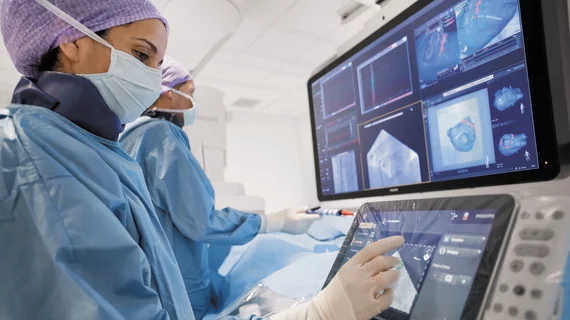Practice change boosts efficiency for interventional radiology procedures handled outside the OR
A novel practice change is helping to boost efficiency for interventional radiology procedures handled outside of the operating room, according to research published Wednesday.
Such use of “Non-OR Anesthesia,” or NORA, is becoming increasingly popular in institutions that handle a high volume of IR cases. However, the specialty has yet to optimize efficiency in these spaces, researchers detailed in Current Problems in Diagnostic Radiology [1].
“Relocating anesthesia services to the interventional suite poses challenges as OR workflows, space considerations, and geography do not seamlessly transfer,” anesthesiologist Justin Routman, MD, and colleagues wrote March 13. “NORA sites must also manage postoperative recovery and complications including cardiorespiratory instability, hypothermia, aspiration and hypovolemia.”
To address this, UAB implemented a novel “timetable” approach in January 2023. Routman and co-authors created it by calculating typical durations for various tasks and then back-calculating each step’s necessary start times to ensure procedures were executed in an efficient fashion. They gave the example of it taking an average of 75 minutes from patient arrival at registration to reaching the IR suite and 45 minutes for the procedure time. This would mean the patient should arrive 120 minutes prior to the desired start (typically 8:15 a.m.), and/or that radiologists should strive to reduce these times.
Routman et al. compared data from 2022 prior to the intervention against 2023 information after the change, totaling 124 first-start-of-the-day cases. Average patient arrival to the IR room improved from 7:49 a.m. to 7:40 a.m. after implementing time tables, while procedure start times improved from 8:31 a.m. to 8:20 a.m. The percentage of procedure start times occurring prior to the goal time increased from 35% to 58%. And except for Tuesdays—when procedures started at 9 a.m., due to a standing anesthesia meeting—on-time starts improved from 17% to 48%, which UAB maintained after the study.
“Implementation of novel timetable targets yielded statistically significant improvement in first-case start times,” the authors reported. “This improvement in efficiency and throughput results in increased room utilization, improved case throughput, and decreased block overrun times, all of which contribute toward increased revenues, decreased costs and thus improved return on investment.”
Read much more in CPDR, including potential limitations, at the link below.

